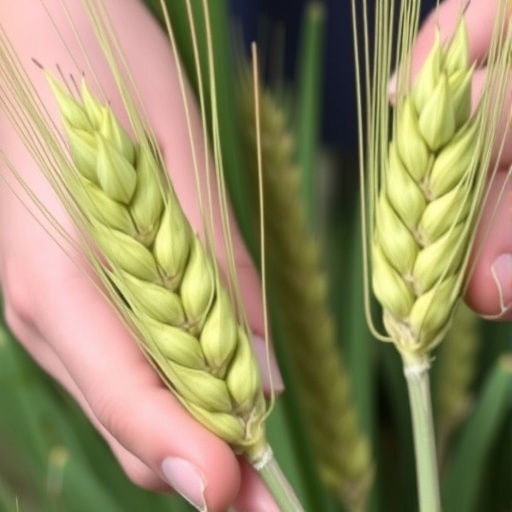In an era where agricultural sustainability and yield improvement are critical, researchers are exploring innovative techniques to enhance crop resilience against various stresses. A pivotal study conducted by Chaurasiya, Das, and Mishra sheds light on a promising technique known as seed priming. This method not only boosts the crop’s growth but also fortifies it against diseases such as Spot blotch, which is caused by the notorious pathogen Bipolaris sorokiniana. This research, published in the journal Discover Plants, underscores the importance of biochemical defenses in wheat cultivation, opening avenues for future agricultural practices.
Seed priming is a pre-sowing treatment that involves soaking seeds in water or solutions containing specific elicitors. This process facilitates the pre-germination of seeds without actual sprouting, essentially “waking them up” and preparing them for a better growth phase. The researchers noted that when wheat seeds were primed with specific elicitors, they exhibited enhanced germination rates and a robust early growth phase. This initial boost is crucial, particularly in regions affected by inconsistent weather patterns and soil degradation, where traditional seeds might struggle.
Moreover, the biochemical pathways activated during seed priming are of significant interest. Chaurasiya and colleagues identified a series of metabolites and proteins that play critical roles in defending plants against pathogenic attacks. The study revealed that seed priming catalyzed the production of protective compounds within the plants. These biochemical reactions serve as a defense mechanism that could effectively lower the incidence of diseases like Spot blotch, directly impacting crop yield and quality.
Bipolaris sorokiniana presents a considerable threat to wheat cultivation, causing substantial yield losses in many growing regions worldwide. The pathogen thrives in environments with high humidity and temperatures, posing challenges for farmers dependent on wheat as a staple crop. Understanding how seed priming enhances biochemical defenses allows researchers to formulate better strategies for disease management, potentially reducing the reliance on chemical fungicides, which are often harmful to the environment.
Additionally, the multifaceted benefits of seed priming extend beyond mere resistance to diseases. The research highlighted how this technique could improve nutrient uptake and enhance the overall nutrient profile of the wheat plants. Furthermore, primed seeds have been observed to develop a deeper root system, which can aid in accessing water and nutrients more effectively. This aspect is particularly significant in arid and semi-arid regions, where water scarcity limits crop productivity.
As climate change continues to alter agricultural conditions, innovations like seed priming are more pressing than ever. This method can not only help crops withstand abiotic stresses such as drought but also enhance their resilience against biotic stresses like diseases. The findings from Chaurasiya et al. suggest that implementing seed priming could yield significant advantages for farmers, contributing to food security and the sustainability of agricultural practices.
On the technical side, the study utilized various assays to measure the biochemical responses in primed seeds. It employed techniques such as chromatographic analysis and spectroscopic methods to quantify the presence of defense-related compounds in wheat. By correlating these findings with increased resistance to Bipolaris sorokiniana, the authors provided compelling evidence supporting their hypothesis that seed priming acts as an effective defense strategy.
Importantly, the researchers pointed out that the effectiveness of seed priming is contingent on several factors, including the concentration of the elicitors used and the duration of the priming treatment. This level of precision is crucial, as it underscores the need for further research to optimize these parameters to maximize the benefits while ensuring minimal resource expenditure.
The dissemination of these findings could transform current agricultural practices. Collaborating with agronomists, seed producers, and farmers will be essential in translating this research into practical applications. By educating farmers about the benefits of seed priming and providing access to technologies that facilitate this process, the agricultural community can enhance crop resilience against an array of environmental challenges.
Despite its promise, the uptake of seed priming in mainstream agriculture is still limited. Increasing awareness and acceptance within the farming community is vital for this technique to gain traction. As such, outreach programs, workshops, and field demonstrations are necessary to showcase the benefits of seed priming and how it can lead to healthier, more robust crops.
In conclusion, the research conducted by Chaurasiya, Das, and Mishra serves as a beacon of hope for global wheat production. Their findings not only unveil the scientific rationale behind seed priming but also highlight its potential to revolutionize disease management strategies within the agricultural sector. As researchers continue to explore the intricacies of plant responses to biotic stresses, techniques like seed priming could pave the way for innovative solutions to the ongoing challenges faced in agriculture.
The implications of this study extend far beyond the laboratory. With wheat being a vital food source for billions of people, enhancing its resilience through such innovative techniques could play a significant role in addressing food security concerns. Overall, seed priming emerges as not merely a technique but a strategic approach in the quest for sustainable agricultural systems in an unpredictable world.
This study propels the dialogue on sustainable farming practices forward, emphasizing the need for integrated approaches combining biotechnology, traditional knowledge, and innovative agricultural methodologies to create a resilient food system for the future.
Subject of Research: Biochemical defense mechanisms in wheat against Bipolaris sorokiniana through seed priming.
Article Title: Seed priming with elicitor induced biochemical defence in adaptation of wheat against Spot blotch (Bipolaris sorokiniana).
Article References:
Chaurasiya, D.K., Das, S., Mishra, A. et al. Seed priming with elicitor induced biochemical defence in adaptation of wheat against Spot blotch (Bipolaris sorokiniana).
Discov. Plants 2, 223 (2025). https://doi.org/10.1007/s44372-025-00307-z
Image Credits: AI Generated
DOI: 10.1007/s44372-025-00307-z
Keywords: seed priming, wheat, biochemical defense, Bipolaris sorokiniana, sustainable agriculture, food security.




